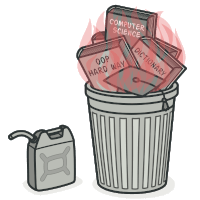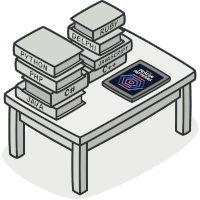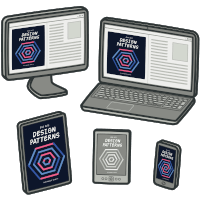直撃! デザインパターン
デザインパターンは、 ソフトウェアの設計においてよく起こる問題を解決する手助けになります。 しかし、 関数やライブラリーと違って、 パターンを単にコピーすればいい、 というわけではありません。 パターンは、 コードのかけらではなく、 特定の問題を解決するための一般的な概念です。 それは事前に描かれた設計図のようなもので、 それを自分のコードで繰り返し起きる問題を解決するためにカスタマイズできます。
本書、 『直撃! デザインパターン』 では、 標準的な 22 種類のデザインパターンと、 それらが基盤とする八つの設計原則を解説します。
- 各章は、 現実世界のソフトウェア設計上の問題で始まり、 パターンの一つを使用してそれを解決します。
- そして、 そのパターンとその変化形の構造の詳細に飛び込み、 コード例が続きます。
- 本書は次にパターンのいろいろな適用例を紹介し、 既存プログラムへのパターンの実装方法を手順に沿って教示します。
- 各章は、 パターンの長所と短所に関する話と、 他のパターンとの関係、 類似性、 違いについての考察で、 結びとします。
パターンを知りたい理由?
面接や考課で高得点を取る。 ほぼすべてのプログラマーの就職面接や人事考課でパターンに関する質問が出題されます。 あなたにふさわしい仕事、 昇給、 昇格の機会をもっと手に入れてください。
プログラミングで使える道具を増やす。 パターンを使うと、 車輪の再発明 (訳註: すでに存在するものを再度発明すること) なしに、 事前に準備された解決方法をカスタマイズするだけですみます。 隠れた問題にも対処済み、 実証済みの標準の解を使うことにより、 ほとんど誤りのないコードができます。
より明確な同僚との会話。 1 時間かけてご自身のすばらしいコードとクラスの設計の詳細を他のプログラマーに説明する代わりに、 単にパターン名をあげてください。 労力なしに栄光を手に入れられます。
本書の対象読者
パターンの初心者に。 パターンをまだ勉強したことがない方には、 本書では実際の例を用いてオブジェクト指向プログラミングの基本原則について説明します。 パターンの話に飛び込む前に、 パターンの基礎となる設計の価値と原則を見ていきます。
パターンの復習に。 しばらく前にパターンを学んだけれど、 あれこれ忘れてしまったという方には、 この本は記憶を呼び起こすための手元に置ける参考書として使えます。 最初から読む必要はなく、 関心のある箇所を直接ご覧ください。
言語の移行に。 C#、 C++、 Go、 Java、 PHP、 Python、 Ruby、 Rust、 Swift、 TypeScript などの OOP 言語の一つに移行する場合、 本書に含まれる図とイラスト満載の、 現実に即した多数の例や喩えが、 コードの本質を迅速に把握する役に立ちます。
無料お試し版
本書の品質をご自身でお確かめください。 お試し版には、 目次、 入門用の数章、 三つの設計原則、 Factory Method デザインパターンの章が含まれています。

完全満足保証
リスクなしで今すぐ購入。 1 か月以内に本書が役に立たないと思われた場合は、 理由を問わず、 購入代金を払い戻します。
お客様の声
Everything is well explained and I like the way all basics are introduced first (UML, SOLID) and then we can go on each design pattern and play with it. The only improvement I see is making printed version available (I prefer paper to pdf) and maybe in another languages.
Your book is great. I am junior level developer and certainly happy with the purchase! I like the structure of how each pattern is presented, and the UML and examples really clarify things. I also like the "vibe", which keeps it fun yet on-point. I can't think of a con. Thanks for this!
The book is awesome, easy-understanding and well-written. Just have a little suggestion to organize the content not in alphabetical order but by categories would be better. And also put some code in it [rather than having it in separate archive] so that it would be easier to read on an iPad when travel.
I read it the same day I got it, I mostly use it as a refresher on on when I dont see the woods for the trees. I think it's fine the way it is.
I have been really busy with work recently. The info you have on design patterns has been a huge help and an excellent reference!
I think what you have currently is well done and the organization is superb!
I only had time to glance at the book but it seems really amazing. I hope to have time since next month to read it.
About the things that made me to buy it are the cartoons and UML diagrams that simplifies the understanding of each pattern. I really like them!
I would like to suggest you to do something similar (including cartoons) with the most famous programming antipatterns.
I have just read the book and I think it is amazing. I have bought both of your patterns books and refactoring course and if you need me to buy from you again I will :)
So far I find this book very interesting and useful in terms of examples/diagrams and ideas. I wish you could have the code written in Java.
I am loving the book so far. I'm currently reading it on my Kindle. I'll use it to make dojos with some friends of mine so that we practice the principles of the book.
As for suggestions, maybe it's a bit too soon to say since I'm still at the beginning and I'm a slow reader, but maybe exercises? I don't even know if the book presents exercises. Maybe it does and I didn't get there yet.
The book is great and makes all the patterns more easier to understand than the books or examples i found on the internet.
I like your style of writting, it`s easy to understand. You are going from the problem to the solution and that process give me the best understanding about pattern.
Comparations betweem patterns are helpful alot.
Maybe the UML diagrams should have cardinality and the role that a class plays in the relationship because it's difficult for the first reading for every problem follow all properties from the code or from the text.
Maybe for some patters you should use the same problem, saving time to understand the new problem but to concentrate just on pattern, and make good comparision of new pattern with the old one. Well it's good to have more different problems for diversity but it's more time consuming and little blury the pattern.
I have already started reading the book, though I'm not quite half way yet. My impressions so far is that I like it! I enjoy the UML diagrams high diagrams explaining the connections and the coding examples. I also appreciate the explanation on when to use a particular pattern and what are it's strengths and weaknesses. There is a lot of good information and I have been re-reading sections to make sure I have a firm understanding as to why a particular pattern is beneficial and how to properly implement it before moving on.
The book is great! I discovered your site a few months ago in my ongoing quest to design better code. I bought the book because it has information on SOLID design principles, and I like that I can read it on a Kindle. I'm a big fan of the illustrations - they're funny and do a good job of illustrating the concepts.
I'm a long-term user of your website refactoring.guru from as early as my undergrad era. I have to say the website (refactor.guru and design patterns) are great! It's the 101 for me to learn how to improve my code in a higher level than just learning grammars and best practices of programming languages.
To me, the e-book is a modernized Design Patterns: Elements of Reusable Object-Oriented Software. Although I've purchased the old Design Patterns book long before and put it on my bookshelf, I seldom read it. Your book changed this awkward situation, because it has a much better look and more readable contents. It also have updated understandings of trade-off, nice illustrations and better summaries for each of the design patterns. Much more attractive to me. And the book is well organized by chapters, letting me to read it through many times on my phone during leisure time.
Sincerely, it's perfect as an e-book to me as a guidebook to improve my skills as a software developer and I have recommended the book to all of my friends. Yet I'm wondering if there is a further plan to make a more "advanced" version. What I mean is that a version with more detailed explanation with the theories behind these design patterns, probably citing some academic researches of software engineering, some industry cases, etc. This advanced book will be the best choice for people who want to dive even deeper into the story behind the scene. Its form might be somehow like that of Peopleware and Pragmatic Programmer where the author introduced the experiences by telling stories or some industry cases they know.
Another advice is that it might be a good business decision to make a paper-based version of the e-book. I believe almost every programmer will be willing to put one on his/her shelf. I noticed the e-book has some hyperlinks as part of the organization. But I believe it's possible to make some arrangement to minimize the jumps and make it highly sequentially readable.
Again, thank you so much for creating the awesome website and book. It's a huge help to me. The thing is that I found trade-offs in software engineering cannot be taught easily in universities. So in the past a newgrad have to spend several years to learn these experiences by working in a big company for years. However, this might not be everyone's ideal career path. Your website and book made it all flatten and now a newgrad or student can learn very quickly by using your website. It enabled an agile career path directly from a startup (or even "non-profit" career path by simply start to working on open-source projects).
I did read your book. Twice. It is a very comprehensive book and a joy to read and to walk through. It serves great as a reference and I probably won't need another reference book for patterns. I like your writing. No lengthy fluff, no excessive jargon, no just dry code. To the point. Also I like the way you explain the design and SOLID principles. Thank you very much.
What I would like to see more in the book is a reference to typical, real life use cases of each pattern. For example, I have heard the command pattern can be used to radio groups or for writing wizards. How is this done? Are there any examples of real life code using the visitor pattern? Are there any simple examples we can study? No need for extra book pages, just a link to a online repo with code examples probably would do. Maybe more examples would help the stick better to the memory.
Yes, it is up to me to come up with good use cases for each pattern but as a newbie I find it difficult to remember what each pattern does and what it is good for. Some, like the singleton, the facade, the observer etc. are obvious and easy to remember their purpose and general functionality, others not so much.
Also it would be great if there was an option for a dead tree version of the book. I want to keep it as reference. I will feed the PDF to my laser printer but I would like to have it printed and bound looking like a real book.
All and all I give your book a solid 5 stars. Thank you very much.
I've read a considerable part of the book already. I loved what I read! You explain the concepts in such an easy way. I wish I had the opportunity to read it when I was in college. I don't have, currently, any suggestions to improve it. But it would be great if it were available in more languages. Since I'm from Brazil, I'm not gonna lie, it would be great to have it in Portuguese (so I could tell my non-English speaking friends to get it as well, 'cause they really need some of the knowledge in the book).
I stumbled across your website when searching "why refactoring is important" if I'm not mistaken. I immediately saved it to my bookmarks that day and shared it with some of my colleagues.
Thank you for the book.
I like your book, it is easy to understand even if I'm not good in English and really really beginner, of course the illustrate each pattern make me smile, real world example and class diagram help me better understanding, relation between pattern really help me to understand when and why pattern exist.
I hope you can write code in JavaScript, because sometime I convert the code into Typescript/ES7
I am half way through the design patterns book and I must say I am more than 100% happy that I purchased the books. I must say you have a knack of telling the things in the right way. I am really enjoying the book and I am very sure even the refactoring book would be great as well.
I like the way topics are presented and the examples. That helped be get the context and better understand them. This way, I will not forget the concepts over a period of time. I wish the SOLID principles content should be expanded a little more by taking a real world complete use case and applying step by step like before and after. I know this kind of thing may be tricky to make, but, it would help.
Moreover, I would suggest breaking the design pattern book in to design patterns and also OOAD book. The OOAD book can focus on SOLID principles, OOP in general and how OOAD can be done. The design patterns then can augment the same.
I am glad to have purchased the books and they will definitely help me in understanding and applying them at my work. Keep up the good work. I will be watching out for any new content that you put out.
I like the way you have explained each of design patterns although I have the original GoF books but it's really hard to understand.
No suggestion as of now I am still in between and I am happy with my purchase. Thanks!
The Design Patterns are something I was not very familiar with. I already learned a lot from your book and I hope I will be able soon to get a new role in my career and maybe to teach other people about the patterns.
Everything is explained very well, the introductory part includes SOLID and fundamentals of OOP which is very good. I would do more examples if I could. What I would put here is a brief of symptoms of a bad design like rigidity, fragility, imobility and viscosity. But for me, it's exactly what I was looking for - design patterns with explanations and concrete examples in one place. And to be honest it was at the best price - personally I wouldn't do it for this amount.
Thank you again and congratulations for your work. I would be glad to share you my pieces of code in the future if you want. Good luck!
This is a very good book you have. This is well explained at the level of the principles and through examples.
My only concern is my level of English which is very low and it takes me a lot of time to understand the quite complex designs. I am a symfony developer and currently I am in the process of deciding the use of these patterns at the framwork level.
The use of SOLID is quite understandable and I think it is the basis, so I did not have the same problems for the factory. It's the others that I'm investing more. I found, for example, that symfony formlaries are rich enough to find use cases (factoryMethod, builder, composite).
This will interest me a lot if you can help me find the use of the symfony designs.
I'm still reading the book, but so far I really like it! It has been a helpful refresher to me on OOP principles. I liked the explanation of UML diagram symbols.
I'm relatively new to design patterns, but you explain them in a very clear manner which is easy to understand. I enjoy the illustrations and the real-world examples. Other material I had previously read on design patterns was pretty abstract without saying how it would be helpful in real life. But your book makes it all very clear!
The book is really awesome and explains the concepts in great detail. I read the book completely and I think its the fastest I completed any book.I am also considering to buy the other book on code refactoring.
The improvements I would like to see in the book is to add some more design patterns. I guess some design patterns from the Gang of Four missing and also some patterns outside GoF which we use most often. Some information on Anti patterns & code smells and also examples of how multiple patterns can be used together within applications would be great.
I would like to thank you for your excellent book. It's one of the best purchases I have recently made and has helped me a ton with work.
I've read the book as soon as I got it after I had read through the examples available on your website, because it convinced me that the information in it would be very useful to me. Since I have got your book, I have kept it open at work on one of the displays as a reference and guidelines for my designs and whenever I extend the functionality of my software I always follow the design patterns presented in the book.
What I love about the book is that it is a recent and modern document about design patterns, which is in my experience the bread and butter of object oriented software design. It is very concise, provides many examples and very concrete applications, and actual implementations in all the programming languages I use at work. While the information in the unavoidable "Gang of Four" design patterns book is very good on its own and a great text, I was looking for a book in the same scope, but a recent one to keep up with the new designs, technology and concepts that come and your book is a perfect candidate for that.
The text itself is pretty, with very nice diagrams and images, great formatting and typesetting. While these are details, they make the information much more readable and enhances the whole experience. And the cover art is very nice !
I honestly have no idea on how to improve the book. It has been a pleasure to read, and has become a very important tool at work and one of my "definite references", so it's difficult to improve something you are already very satisfied with !
So, thank you again, props to you for making this great text. The first recommendation for books about design patterns and object oriented software design that I would give would be definitely yours, hands down.
I’ m very happy with the book. It’ s easier to read than a GoF book.
- I can’ t say anything bad.
- Complex structures are explained in an easy to understand way.
- I believe it would be great if a few chapters on anti-patterns were added.
Overall, thank you very much for the high-quality material.
I liked everything, I read it only once for now. And I have not yet found anything that could be improved. I keep it in my favorites as a reference book.
I use your website, and bought the book to support the project! I like everything very much. Simple and user-friendly! Keep it up!
To my surprise, the book is very well suited for different levels of specialists. That’ s why we even added a link to your website as a recommendation.
I enjoyed the illustrations and the method of presenting the material. Thank you for popularizing useful educational materials.
I believe the presentation is ideal: brief, without unnecessary discussion. A clear description of the problem, a way to solve it, a pseudocode: all you need is there. Illustrations also help a lot. If I need to remember why one or another pattern is needed, I just look at the picture and I remember everything.
This is what could be improved, in my opinion. Maybe a few more examples of the practical application of a particular pattern. Without a code. Just a description of the situation and its solution using a pattern. I.e. real-life examples. I am, of course, more interested in Web development.
I'm reading the book right now. The website has almost everything that is written in the book, so technically I could have just read about it on the website. As to what could be improved, it is difficult to say. Sometimes you write about the same thing over and over 10 times, but many of us (including myself) need it for initial understanding.
I would love to see more examples, maybe even without code. For example - you can talk with developers from different industries and ask around, where and how they apply this or that pattern.
I’ m an Android developer and some of your patterns are stacked on commonly occurring screens. Maybe you should add some links to designs of other guys as an example.
But overall the book is quite good. The pictures are cool. Sometimes it's hard to figure out what's what, but what can you do? We must persevere. Read again, try again.
It would be great to see the version for Kotlin. I actually rewrite your examples in order to learn the language.
I started reading the book, and I'm very pleased with it. Great, high-quality examples and schemes.
My first impression is a positive one, the author should continue writing. I'd like to buy the book for a friend. I understand that the only option is to register under a new account.
I previously studied these patterns in the book titled “The Gang of Four” . I liked the simplicity of descriptions in your book, as well as the excellent usage examples. I use your book as a reference guide in order to refresh my knowledge about a particular template or to search for a template I may need at the moment. I can't say anything about how the book can be improved, because I haven't even thought about it.
The author did a great job creating this book)
Thanks for the great material! I'm reading the book in sections, I really like how the material is presented, user-friendly presentation on several levels, interesting examples, clear illustrations. I can't help but compare it to Freeman's “Design Patterns” , and the presentation in your book is more informative in my opinion. It is convenient not only to read the book in a sequential order, but to also use it as a reference guide.
I plan to use the materials you have collected to put together training materials, reports inside and outside my company, in the context of front-end development.
Truth be told, I bought the book to give back for the work the authors did when creating the website, it helped me and continues to help + I was interested to see how SOLID will be outlined.
I think it would be cool for newbies if there were c# examples as well, although everything is quite clear anyway. Since I have a stable Internet connection, I use the website as a reference guide instead of the book.
I'm reading the book, it's interesting, not boring, and it offers quite an exciting and fresh perspective. I would love to see it a paperback edition as well.
Thank you for the book. The material is presented beautifully and in a user-friendly manner. The examples are clear, the diagrams are accurate, the illustrations are interesting. It works as a reference book, as well as an introductory guide for the topic. I use it for both purposes.
I work as a C# developer. I had read an article online that included many references to patterns. I went to Google and found your website, where I read about the pattern that was of interest to me. Your information is very well structured, but what I liked the most was the style of illustrations. There is something home-like about them)) As a beginner, I really liked the fact that the patterns are described from the point of view of the issues that they solve, and not from the standpoint of the description of the pattern itself. After reading the entire section on patterns on the website, I realized that I wanted to buy the book to thank you for the work you have done collecting and structuring the information.
I would like to comment only on one section - “Relationships with other patterns” . Despite the fact that I read about all the patterns, I still don't understand what this section is about. Maybe you could add illustrations there, or even remove this section altogether and add a chapter about using combined patterns?
The project as a whole, and the book in particular, make an excellent impression. It would seem that there are quite a lot of books written on this topic, but you have structured everything and made it rather fun) Wonderful illustrations that help readers memorize everything in a fun way.
I started reading the book right after I purchased it. I've already learned how to apply a couple of the described patterns quite confidently in practice.
The book can be improved by publishing it on paper. That way you can give it as a gift, for example.
I would like to see examples for PHP and Python, but as I understand, you are already working on it.
Thank you for your work, and good luck in your endeavors!
I am completely satisfied with the purchase, I have already read the book from cover to cover. I think that this is the most user-friendly book on patterns I have ever read. I was really happy that I could read it on my iPhone. Thank you for the great book!
Excellent book, everything is explained in detail and presented in a user-friendly manner. Special thanks for supporting multiple formats and providing the readers with the ability to read the book on the go.
I liked the book; from time to time I apply the solutions from the book in my work.
I'm pleased with the book and very thankful for your work.
I would like to note right away that the book is beautifully illustrated) The information about SOLID, and in particular, about the principle of Barbara Liskov, is presented very well and in a user-friendly manner. I found some new information for myself about the private members of the base classes and the fact that you explicitly separate the restrictions on preconditions by type and attribute values. It is really easier to figure everything out this way.
It seemed strange that the book is over 30mb, though
The book is great. Excellent illustrations and examples. I am now preparing a report on Design Patterns at work.
What can be added: examples with Anti-Patterns, what not to do.
I do really enjoy your book. And would like to buy printed version to have it on my work place.
Everything that is explained using cats is always clear, and the more allegories the better. I haven't finished the book yet, but the first impression is rather good, thank you!
I confirm that I bought this book, and am satisfied with the purchase, otherwise I would not have bought it :)
I was looking to find some information on the most widely used patterns (builder and factory), and I ended up finding the materials on the website. And everything after that is history - I really liked the design of the website and its structure; other similar resources usually just have a description of random ~5 patterns, and the rest are “coming soon...” .
Your website is by far the BEST of all that I have come across on this topic, and that's why I bookmarked it and added the PDF version to the offline library on my tablet. Although I am an experienced “pirate” , I am always happy to pay an ADEQUATE price for the product that I use for my professional activity.
I almost finished reading the book. I will say right away that I liked it; the book offers real-life examples, the descriptions and the pseudocode are good.
The material is interesting, even though it was a bit unusual to learn on examples with pseudocode. For pros, this approach is, of course, quite acceptable. In general, the book is definitely worth its price.
製品内容
多言語電子書籍を 4 形式で
- 形式: PDF、 EPUB、 MOBI、 KFX
- 言語: 日本語、 英語、 中国語、 韓国語、 フランス語、 ポルトガル語、 ポーランド語、 ロシア語、 スペイン語、 ウクライナ語
- ページ数: 461 ページ (英語版)
- 図表数: 225 (図とイラスト)
- 更新と修正: 無料
コード例の書庫
- コード例の言語: C#、 C++、 Go、 Java、 PHP、 Python、 Ruby、 Rust、 Swift、 TypeScript

ヒトにやさしい、 自然な言葉の電子書籍。 業界用語や技術用語の使用を最小に抑え、 コード例と図表が多数。

特定プログラミング言語に不依存。 コード例はほとんどの OOP 言語に適用可能な疑似コードで書かれています。

どんなデバイスでも読書可能。 電子書籍は、 4 形式で配布されます。
- EPUB は、 スマホとタブレット用
- MOBI と KFX は、 Amazon Kindle 用。
- PDF は、 あらゆる場所での読書と印刷用

いつも手元に置け検索可能。 電子書籍は便利な参考書です。 文庫と違い、 検索可能な上、 置き忘れがありません。 スマホ、 タブレット、 ラップトップとデスクトップでいつでも使えます。

通勤中でも、 くつろぎ中でも読書を堪能。 近頃は、 他にどこで学べるでしょう? ひょっとして、 飛行機、 バス、 地下鉄の中でも? ひょっとしてベッドの中でも?

昼間も夜間も読みやすい。 夜更かしの皆さんへ朗報です! 電子書籍は昼間の明るい背景でも、 夜中の暗い背景でも、 よく見えます。
よくある質問
その他質問がありますか?
フォーラムでメッセージを送るか、 support@refactoring.guru まで電子メールを送信してください。 通常数時間内にご返事さしあげます。
 冬のセール!
冬のセール!




